With more than 1.3 billion monthly users, Facebook Messenger offers a direct gateway to more consumers than any other platform.
If you've ever used it (and we're willing to bet good money that you have), you might be questioning how you can possibly use a simple messaging app that you thought was only good for keeping in touch with your aunt in Australia to get more customers.
But actually, Facebook Messenger is revolutionising the way brands market themselves to their customers.
Think about it:
You get direct access into inboxes - but not just any inboxes; inboxes that 70 million people log in to every single day.
Despite this, the lion's share of ecommerce businesses are still struggling to get their head around how they can tap into this well of potential buyers.
Why Facebook Messenger?
We should start by tackling why Facebook Messenger is a good tool to integrate into your marketing arsenal.
As well as having a ridiculous number of daily users, there are more than 2 billion messages sent back and forth between users and businesses every month. This shows that consumers are ready and willing to communicate with brands there.
The direct approach provides an unrivalled opportunity to move consumers through the sales funnel and, with the ever-evolving advent of chatbots and AI solutions, you can now provide personalised experiences at scale (if you didn't already know, shoppers go crazy for personalised experiences).
In fact, 69% of shoppers actively seek out personalised experiences, but only 40% of brands offer them. If you can get ahead of that 40%, you're onto a winner.
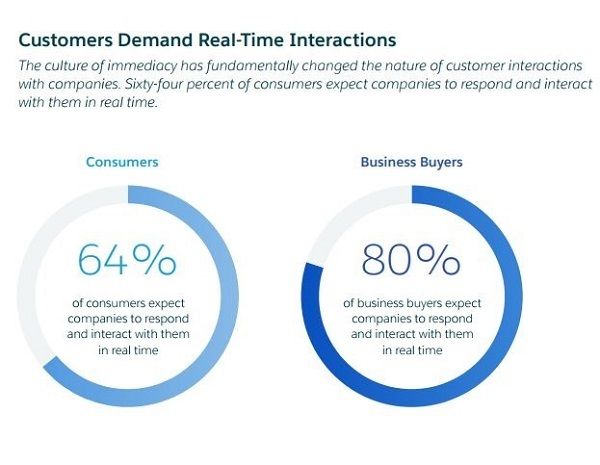
If that wasn't enough to convince you, let us remind you that we are living in a now, now, now culture, where consumers want things to happen in-the-moment. Basically, customers are impatient: 90% expect an immediate response to a customer service question they have for a brand.
There's no better tool than Facebook Messenger to feed into that instant gratification culture. And now, the platform has introduced the ability to buy products directly through the app, which has the potential to be an absolute game-changer for ecommerce businesses.
Here's how you tap into the benefits of Facebook Messenger and boost your sales.
7 Ways to Use Facebook Messenger to Improve Sales
- Use a Chatbot as a Retail Assistant
The simplest and most common way ecommerce businesses are using Facebook Messenger is by "employing" a chatbot in lieu of a retail assistant. This means that, instead of spreading your real-life customer service team too thin, you can tackle FAQs quickly via automation.
Start by setting your chatbot to ask customers multiple choice questions and take their lead to recommend relevant products just like Shop Spring does here:
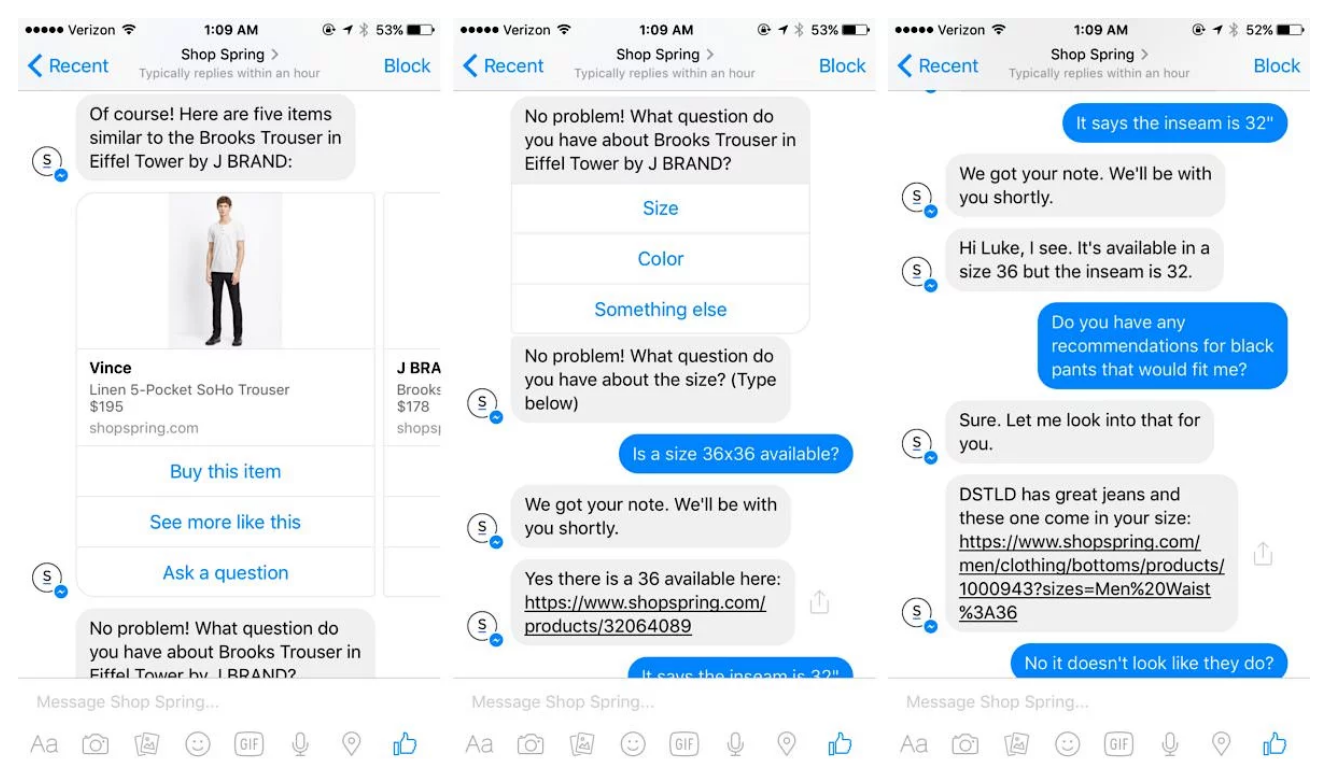
As you can see, they ask the customer a question, the customer answers, and that triggers another question. This approach allows the customer to get basic information quickly without having to browse through pages and pages of your site or send an enquiry email for one simple question that can be answered in moments.
According to research, 54% of shoppers leave an ecommerce site because they can't find what they're looking for (this is the second biggest reason for departure). A chatbot will help them with that, boosting the amount of people who go on to buy from you.
2. Recover Abandoned Shopping Carts
Abandoned shopping carts are rife.
In fact, the average abandonment rate is 69.57%. This means people are happily throwing items into their cart, merrily making their way to the checkout, and then putting the brakes on quicker than you can say "would you like a receipt with that?".
There are a slew of reasons why consumers drop their cart like a hot potato (shipping costs too much, they navigate away from the page and forget to come back, or they were just browsing, for example), but that doesn't mean you've lost them forever.
The majority of ecommerce brands have clocked onto the fact that an abandoned cart is not necessarily a lost customer, so they send an email reminder of the abandoned haul.
But we all know how emails can easily get missed, right? They get packed away beneath tons of regretful newsletter subscriptions or filed away in the never-checked promotions folder.
Instead, send a message via Facebook Messenger. People today are glued to their phones and a ping from FB is likely to garner at least a glimpse at the screen.
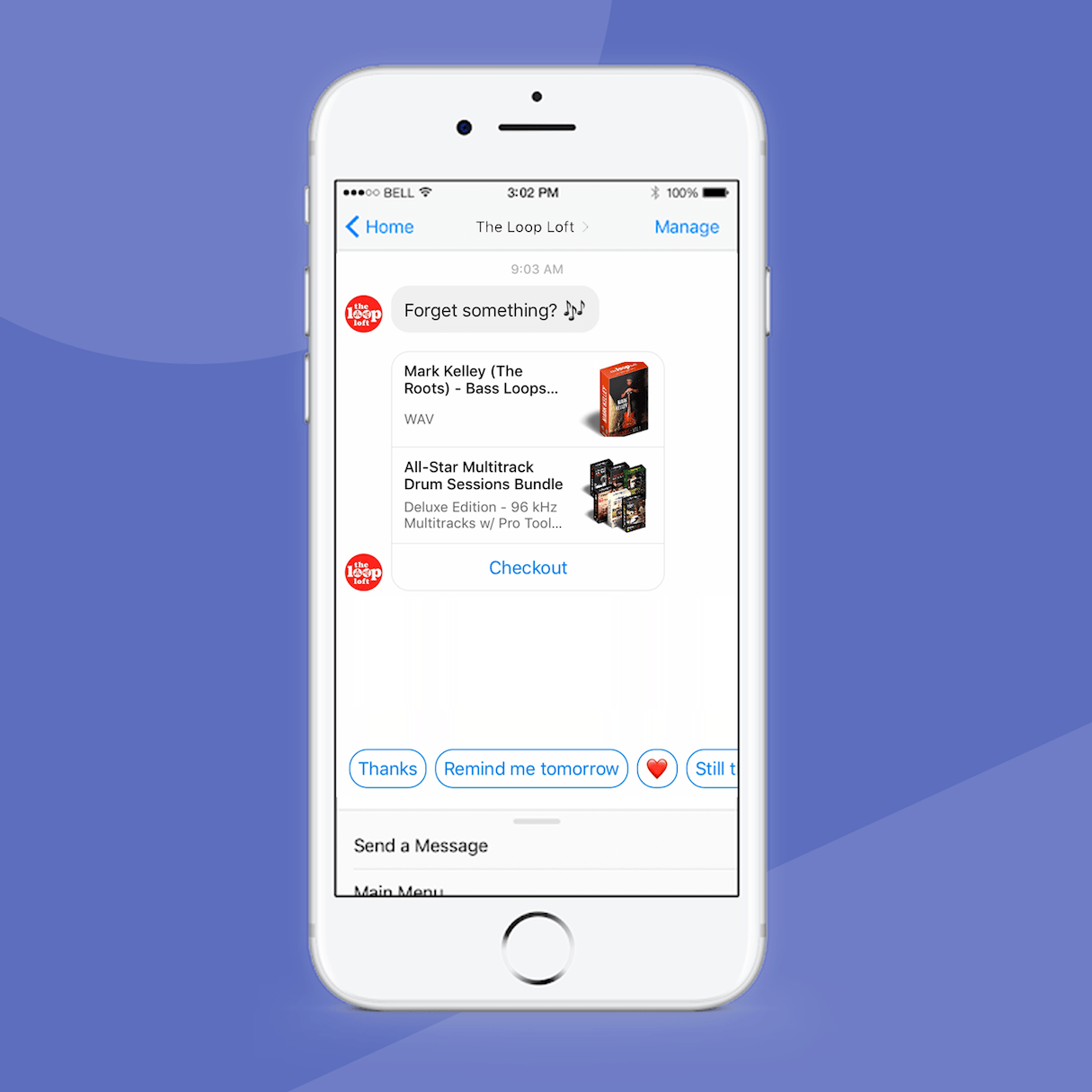
Sending a cart remind like The Loop Loft does here can have a success rate of up to 29% - imagine what that could mean for your sales.
3. Check In With Past Customers
Imagine someone has just bought a pair of shoes from you. In about a year, once they've worn them to death, they're going to need another pair.
But what if they forget where they bought them from? What if they can't find them again on your site? There's a high chance they might jump ship to a competitor.
Wouldn't it be great if you could jog their memory or remind them that you're still there with their favourite pair of shoes?
The good news is you can with Facebook Messenger. If you have access to a customer's previous buying history, you can send automated reminders for them to buy a new product when they need it.
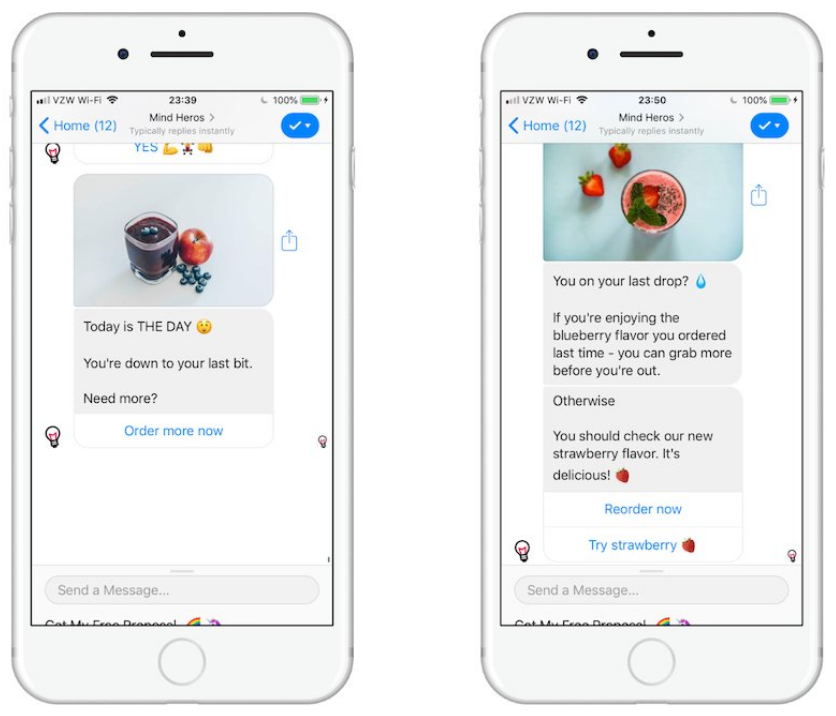
Make like Mind Heros does here and remind customers when their order is about to run out or when they could do with an updated item.
4. Improve Customer Experience
One study found that you can lose as many as 15% of your customers if you ignore social media requests. On the flipside, revenue per customer can grow 20-40% for businesses that do respond.
Great, right?
Except, replying to every single request can be time-consuming and drag you away from other parts of your business. This is where Facebook Messenger can swoop in and save the day, providing simple customer service requests and making the funnel a lot more slippery (better customer service equals more sales, if you didn't already know).
For example, you can send order confirmations and shipping updates to customers who have just made a purchase. This keeps excitement levels high and maintains the dialogue with your buyers after they've handed over their cash.
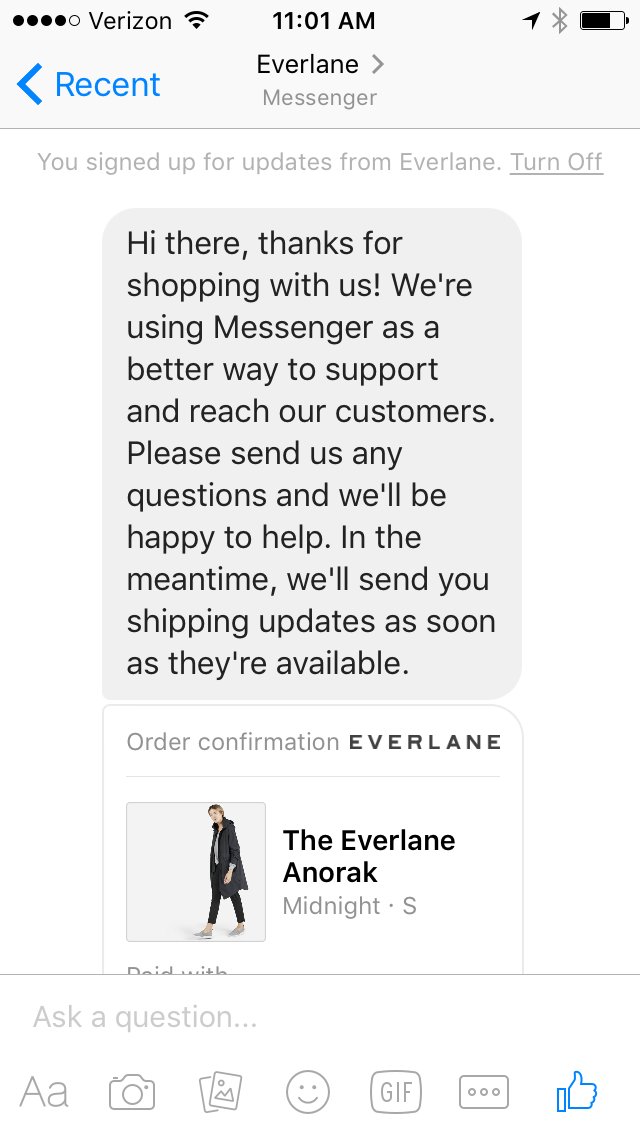
Everlane sends customers a confirmation when they make a purchase and then they follow that up with shipping information so the buyer is in the know from the moment they make their purchase to the moment they get the product in their hands.
You can also offer customer service in other ways.
We've all been excited at the prospect of buying an item only to find it's not in stock. Imagine if you could remind interested shoppers when that item is available again and let them buy with one click.
Guess what? You can!
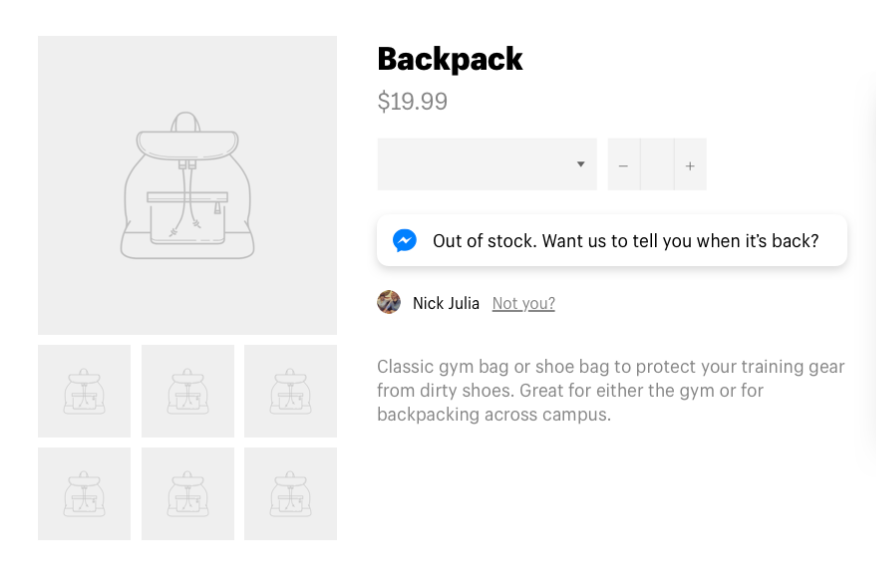
This company offers shoppers the chance to get an update via Facebook Messenger when the item is back in stock, which stops them running off and shopping elsewhere.
5. Upsell and Cross-Sell
As soon as a customer has made a purchase, you have a handy insight into their buying habits and the products they like. This information can be incredibly powerful if you use it in the right way.
Upselling and cross-selling essentially means sharing other items you think customers would like based on their past purchases.
Say, for example, someone buys a scarf. The next logical step is gloves, right? You can send the customer a selection of gloves they might like and even offer a discount at the same time.
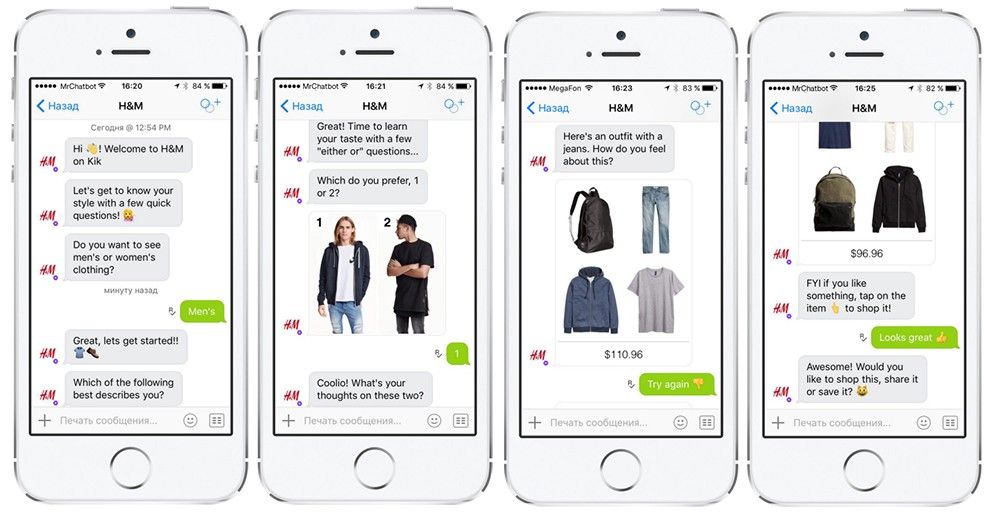
Here, H&M tries to upsell a whole outfit when a customer shows an interest in a pair of jeans.
The key with upselling is to not be pushy. A relevant, well-targeted suggestion every now and again will go down well, but constant sales-y spam is a huge turn-off.
6. Consider the Entire Sales Funnel
Are you one of those ecommerce brands that only focuses on bottom-of-the-funnel buyers? If so, you could be missing out on a huge amount of sales.
In fact, the largest pool of potential customers sits at the top-of-the-funnel waiting (subconsciously) for you to sweep them off their feet. The thing is, consumers at this end of the funnel need a different kind of nurturing than those who are on the brink of buying or who have already bought.
These people don't want sales spiel thrown in their faces because they might not even know they need your product yet. In this instance, you ideally want to serve them relevant, useful information that can inform their buying decision.
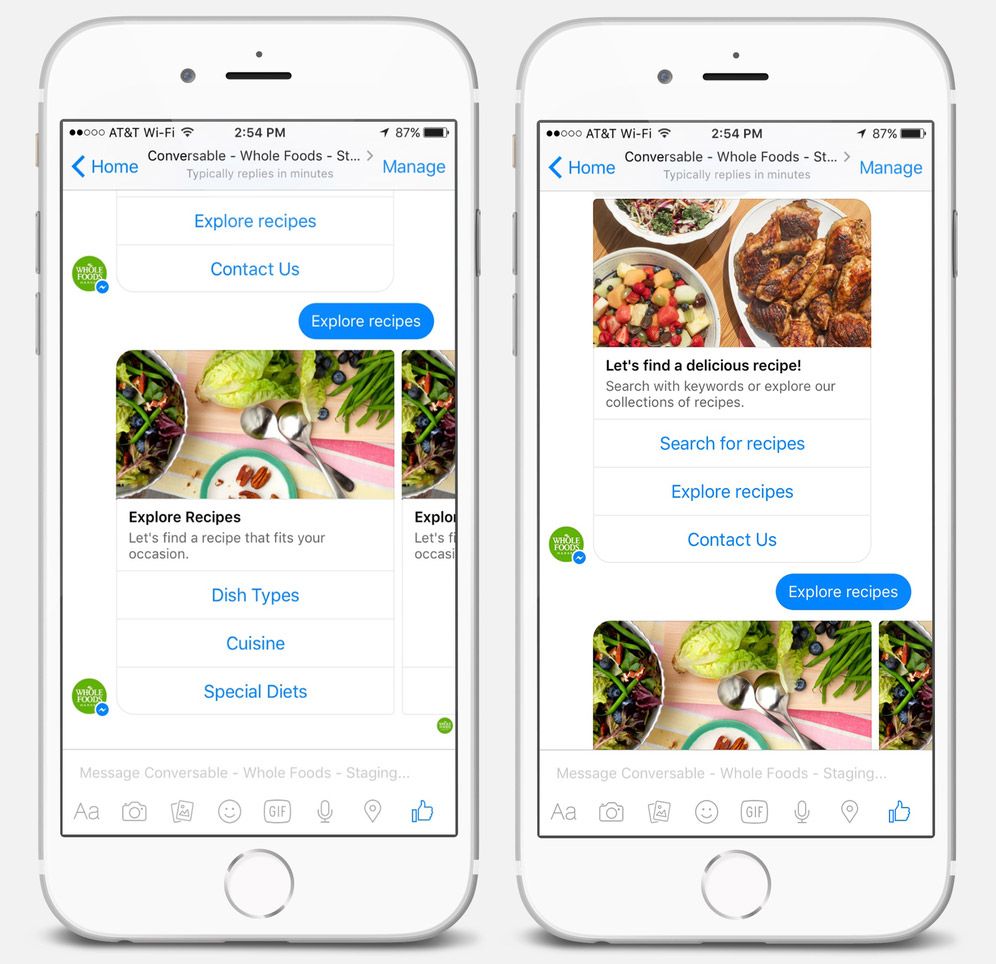
Take this whole foods store as an example. Instead of pushing their products, they instead invite consumers to explore recipes. Once a consumer finds a recipe they'd like to try, the whole foods store can then suggest products for them to buy.
7. Let Consumers Browse Products
Facebook Messenger's latest (and probably the most game-changing) feature is the ability to browse and buy directly through a message.
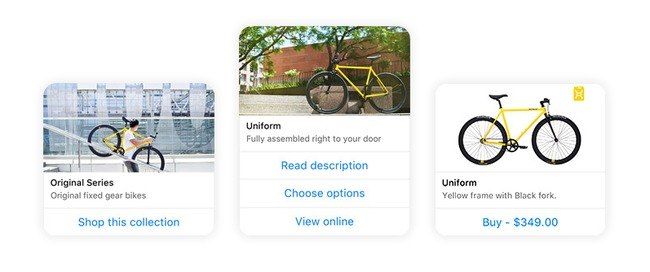
Set up your Facebook Messenger so that when consumers type in an item, they are served a selection of ways they can browse or buy that product. In the example above, you can see that consumers can either "shop this collection", "view online", or "buy".
Providing the consumer with all the information they need in one place reduces the risk of them going elsewhere to make a purchase.
Is Facebook Messenger the Future of Ecommerce Sales?
The great thing about using Facebook Messenger to increase your ecommerce sales is that you can implement it at every stage of the buying cycle.
In fact, consumers don't ever have to leave your message thread because they can get all the information they need right there, from educational content that validates their decision to buy from you through to the final purchase.
In an age where consumers want instant gratification as well as personalised, interactive experiences with brands, Facebook Messenger is a beacon of hope for ecommerce brands who are rushed off their feet trying to juggle customer service, post-sales enquiries, and everything in between.
Sign up for a free trial with Shiptheory to automate even more of the sales funnel.